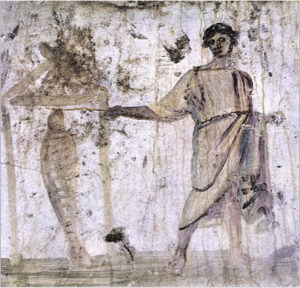You start to notice it from the art of the early centuries of Christianity: in the Roman catacombs alone there are over 55 paintings of Lazarus’s resurrection. Roughly an equal number depict this ministry-changing event (told only in John’s Gospel), on Roman sarcophagi, the marble caskets where nobility were buried. Dozens more depictions of Jesus’ close friend show Lazarus rising from the grave on exquisite materials of ivory, glass and metal objects that didn’t have anything to do with funerals.
Perhaps all these artistic renderings of Lazarus’ emergence from his tomb three days after his burial are the reason behind historians’ belief that the raising of Lazarus made a deeper impression on early Christians than almost any other New Testament text.
Maybe that’s as much a surprise to you as it was to me. All this Lazarus focus didn’t fit with my overall impression of the way Biblical events have been depicted in art. But then I realized many of my impressions were from medieval art –more numerous in the world’s museums than depictions from the 2nd, 3rd and 4th centuries. By the medieval and Renaissance periods, it was Mary’s annunciation and Jesus’ birth, along with his resurrection that trump other New Testament Scriptural scenes.
So why the Lazarus story? And what role does it play in John’s Gospel? I remember the first time I realized that because the Gospel story is told in chronological order, with events building on each other, it would make sense to start paying attention to where stories and healings occurred within the whole Gospel. That’s revealing in the Gospel of John. Go find your Bible and look up the chapter where this pivotal experience occurs. I’ll be ‘waiting’ when you return.
So you found it was Chapter 11. How natural to then ask: why did the evangelist (John’s author) put this story here? Because Lazarus’ resurrection is the climax of Jesus’ public ministry. From that startling prologue that opens the Gospel, we see a steadily building rhythm of signs, revelations of Christ Jesus’ identity (the seven “I Am” statements) and more. The raising of Lazarus is a fitting zenith for ‘the Word made flesh that dwelt among us’.
how different it is from the synoptics (Matthew, Mark and Luke). The author constantly asks us — indirectly–do you understand who Christ is? There are dozens of names for Jesus throughout as clues to his spiritually unique identity, such as the seven “I Am” statements (i.e. the bread of life, the vine, etc.). Keeping track of these names as they roll out helps us get underneath the familiarity and make us think in new ways nd one of the joys of reading it with others in a Bible Study group, is sharing all the names of Jesus the author uses.


